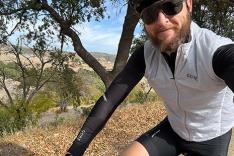Such a question has been extensively modeled mathematically in a number of studies, and also tested on a simulated course on CompuTrainers. However, somewhat surprisingly, this idea hasn't really been scientifically tested out in an actual real-life riding situation. A new study by Cangley et al. (2011) from the UK sought to correct this deficiency:
More: Training for a Time Trial
Cangley et al. 2011
The design of the study was fairly straightforward while at the same time requiring some pretty complex mathematics:
- Twenty-one cyclists and regular time trial riders were recruited. This is a nice improvement over the typical 10 subjects used in many physiology studies. The riders were all regular participants in local 16K time trials.
- Subjects rode a 4K course while maintaining a standardized bike position on their own bikes. This was done four times: twice in a "fixed power" and twice with a "variable power" strategy. Therefore, subjects acted as their own controls and comparisons. Wind speed was less than 5 meters per second and fairly constant throughout the experiment, as was traffic volume.
- The course profile was not a simple flat course, nor was it a "simulated" course with a single hill at a constant grade. Rather, it took place on a straight dual carriageway with essentially minimal flat stretches, a highly variable terrain with an average grade of 3 percent, and a peak of 9 percent. The start and finish were at the same elevation.
- In both constant and variable power conditions, the aim was to average 255 watts throughout.
- It was recognized that it would be impossible for subjects to actually maintain a perfectly constant power throughout the time trial. Rather, the aim was to go for as constant a power as possible in those trials. Subjects wore an earpiece with a regular audio reminder for power at different parts of the course.
- For the variable power condition, a mathematical model was first used to construct an "optimal" power profile based on the course and an average power of 255 watts. Other parameters, such as maximal deviation from that average power (+/- 27 percent), were inputted into the model. From this, subjects had an audio program guiding them for "required" power for each 80 meter segment of the time trial.
- 2
- of
- 3








Discuss This Article